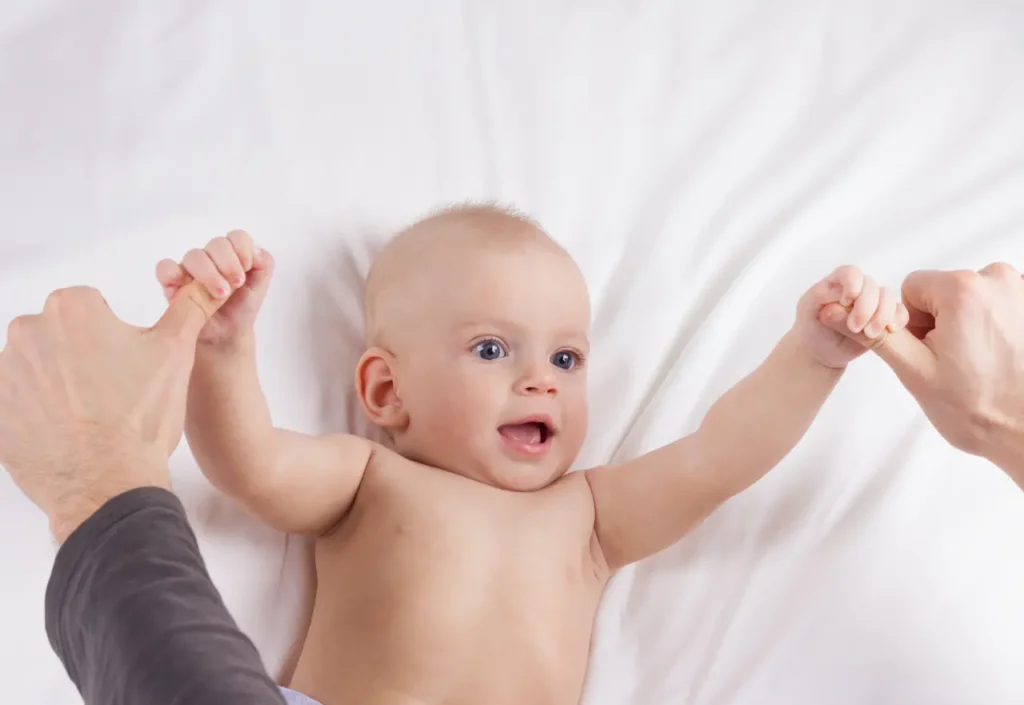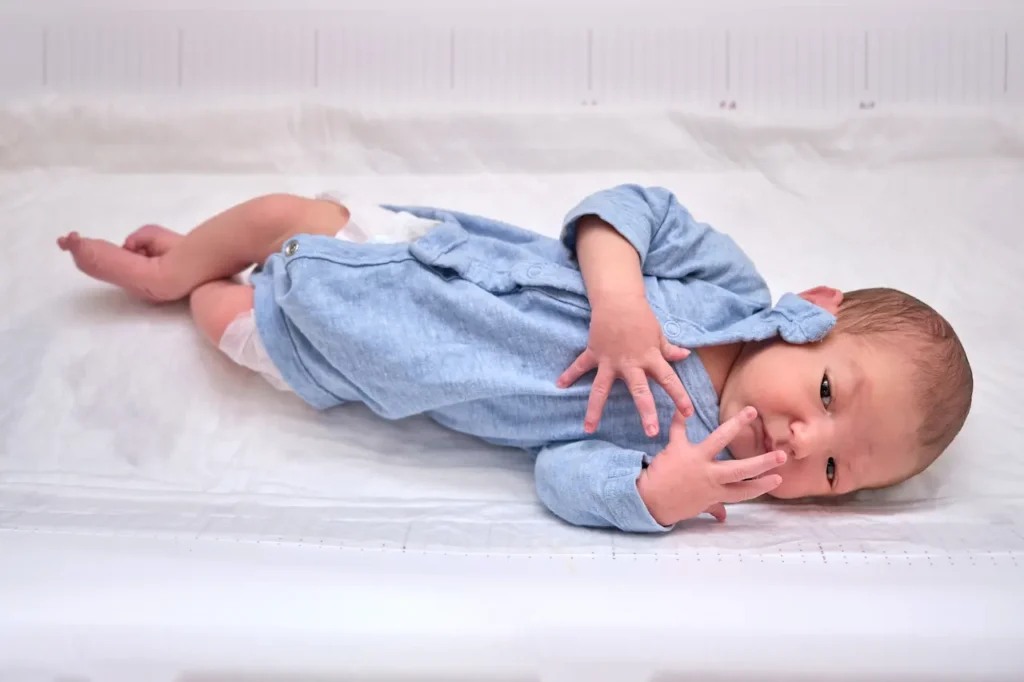The reflexes that are instilled at birth into the baby’s nervous system and brain serve as a foundation for their future development. They may appear to be simple automatic reactions but they’re designed to help babies survive, feed, bond with caregivers, and prepare them for their motor skills later in life. This blog will explore nine reflexes every baby has and how they help to promote your baby’s survival and growth.
1. Rooting Reflex: The First Step Towards Nutrition
Rooting Reflex is one of the most important and first reflexes babies have. This reflex is activated when you stroke your baby’s cheek. Your baby will open their mouth and make a sucking movement without hesitation when you stroke the side of their cheek.
Newborns need to latch on to their mother’s milk or bottle in the early stages of development. It’s a survival reflex that helps infants get the nutrition they need in their early years when they can’t coordinate voluntary movements. This reflex is automatic, and your baby does not have to be aware of it.

Around 4 months, the rooting reflex usually fades as babies start to gain more control over their feeding abilities. As babies mature, this instinctive search behavior is less important as they begin to learn how to feed themselves.
Why is it important: The reflex helps establish a baby’s feeding schedule. It is important because,e without it, babies may have trouble finding food during the crucial days following birth.
2. Moro Reflex: The Startle Response
The Moro Reflex is one of the most well-known and dramatic reflexes babies exhibit. It is also known as the startle reaction. This reflex can be seen when your baby’s neck and head are supported in an upright position. When you lower your baby suddenly backward, or they hear a loud sound or experience a sudden movement, their reflex is to extend their arms and legs and throw their heads back.
This reflex can appear alarming at first because it mimics an instinctive response to fear. It is believed that the Moro reflex helps babies respond to sudden changes in their environment such as a feeling of falling or an unanticipated noise. Experts believe that it may have been a way to keep babies from falling out of their caregivers’ arms or off support structures during the first few years of life.
The reflex is at its peak between 2 and 4 weeks of age and slowly disappears after 8 weeks as babies develop better muscle control.
Why is it important: It helps your baby respond quickly to sudden stimuli and protects them from harm. As babies develop, they begin to learn how to calm down and gain more control of their movements.
3. Walking/Stepping Reflex: A Sneak Peek into Future Mobility
The Walking Reflex is also called the Stepping Reflex. It occurs in the first weeks of life. You’ll see your baby start to walk instinctively when you place them upright on a flat, firm surface. These movements can look like a person is walking with one foot in front of another. This reflex is more primitive than walking, as your baby’s muscles are not strong enough to carry their weight.
The reflex may seem to be your baby practicing walking, but it is only temporary and will disappear after the first six weeks. This reflex will return around 8 months when your baby begins to learn how to walk on their own. Your baby will start practicing voluntary movements such as crawling, standing, and cruising on furniture.
It is common to refer to the walking reflex as a precursor of voluntary movement. This reflex indicates that the body of your baby is preparing itself for future motor development, and developing the coordination required for more complex physical abilities.
Why is it important? A baby’s walking reflex is a sign that their body is ready for physical development. It lays the foundation for them to crawl, stand, and walk.
4. Plantar Reflex: A Lifelong Response
Plantar Reflex is an automatic response that is present in every newborn baby. It is also a reflex we carry with us for the rest of our lives. You’ll see that when you run a pencil along the bottom of your baby’s foot or run your finger over it, their toes spread out and their foot turns inwards and downwards. The plantar response is what we call this. The foot can also turn upward in some cases. This is called the Babinski reaction.
The Babinski reaction may be assessed in adults as part of a neurologic exam. The Babinski reaction is normal for babies, but it should disappear as children grow older and adults age.
This reflex is more than a developmental milestone. It’s part of our nervous systems that help our bodies maintain strong connections between our feet and our brain. Plantar reflexes will help babies eventually learn how to walk, stand and do more complex motor movements.
Why is it important? It’s vital for the coordination of the body between the foot, the brain, and the balance.
5. The Palmar Reflex: The Gripping Instinct
The palmar reaction is also called the grasping response. When you place a finger or small object gently in the palm, your baby will curl their fingers around it and grasp it tightly. The reflex is so strong, that some newborns will even be able to support their weight briefly if their hands are wrapped around your finger.
This reflex could be linked to the baby’s need to stay in contact with his or her caregiver. It gives them a feeling of stability and security. This reflex is also believed to be a form of survival, allowing babies to cling to their caregivers in their early weeks.
As your baby develops more control of their hands, the palmar reflex will gradually diminish between 3 and 6 months old. They will now begin to reach out with their hands and develop more refined hand-eye coordination.
Why the palmar reflex is important: It helps your baby to feel secure, as well as develop motor skills that will allow him or her to grasp, hold, and manipulate objects.

6. The Fencing Pose
Another unique reflex is the fencing reflex. You’ll see that when your baby’s face is turned one way, the arm facing the other side will straighten. This position is similar to that of a fencer getting ready for a match.
This reflex helps babies develop head control, muscle coordination and balance. This reflex is important for helping babies reach milestones such as rolling over, standing up and crawling.
This reflex may be present at an early age, but it will typically disappear around six months as your baby becomes more deliberate and less automatic.
Why is it important? Tonic neck reflex helps develop head and neck control. It’s also an important step towards achieving other motor abilities like sitting up and rolling.
7. Reflex Galant: Crawling
The galant reflex, one of the most fascinating reflexes babies can display, is very interesting. You can trigger this reflex by gently running your finger along the spine of your baby. You’ll see that your baby’s body will move toward the side you have touched as if it were trying to crawl toward the stimulus.
It is thought that the Galant reflex prepares your baby to crawl by helping him develop control of his back and torso muscles. Around 4 to 6 months old, this reflex usually disappears as your child becomes more adept at moving their body.
Why the Galant Reflex is important: It helps babies develop muscle coordination that will help them crawl, a skill essential for greater independence.
8. Swimming Reflex: An Instinctive Water Response
When placed face-down in water, newborns will display the Swimming reflex. Although they can’t swim, they will paddle and kick their legs to simulate swimming. This is an instinctive response when a baby is submerged in the water baby may have the strength and coordination to swim. However, this reflex is not a sign of readiness to swim. It is important to remember that babies should never be left face-down in the water, without supervision. They can easily swallow water, and drown.
This reflex usually fades between 4 and 6 months.
Why is it important: The swim reflex is an interesting survival instinct. However, it should be used safely and under close supervision.
9. Babkin Reflex: Sensory Response
The Babkin Reflex is an interesting but lesser-known reflex that babies exhibit. Pressure on both palms of a newborn will cause them to either open their mouth or rotate their head. This reflex is linked to the baby’s sensory processing ability and helps them engage with their surroundings.
The Babkin Reflex is not as common as other reflexes but it still has a significant impact on how babies react to their environment and start processing sensory input.
Why is it important? Babkin reflexes support sensory processing and help babies interact with their environment. This is crucial for later stages of developmental development.

Conclusion
Reflexes are vital to a baby’s survival and development. They are fascinating to watch. These reflexes help babies to meet their immediate needs, and navigate the new world. They also support their growth. These reflexes, while temporary, serve as a foundation for more complex skills to develop with time.
Each reflex has a distinct role to play in the early stages, whether that’s feeding, motor control, or sensory awareness. These reflexes provide babies with the tools to interact with their environment, form bonds with their caregivers, and master skills that they will need as they grow. Understanding these reflexes will help parents to demystify newborn behaviors, and reassure them that their baby’s reactions are normal and necessary for development.
These reflexes will slowly fade as your baby grows and develops more control of their body. They will be replaced by learned motor skills and voluntary motor skills. These reflexes, such as the Moro, grasping, and other reflexes, will eventually evolve into more purposeful actions, like walking, reaching, and talking. The fundamental purpose of all these reflexes is the same, however: to help the baby transition from total dependence to greater independence.
It is amazing how complex human development is. The way babies react to their environment right from birth is an example of the wonderful and intricate process of growth. These reflexes are not only a source of curiosity but also a sign that nature is preparing babies for the world.



